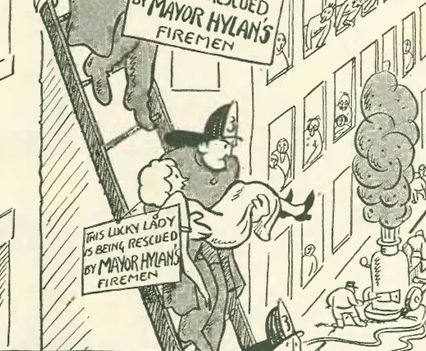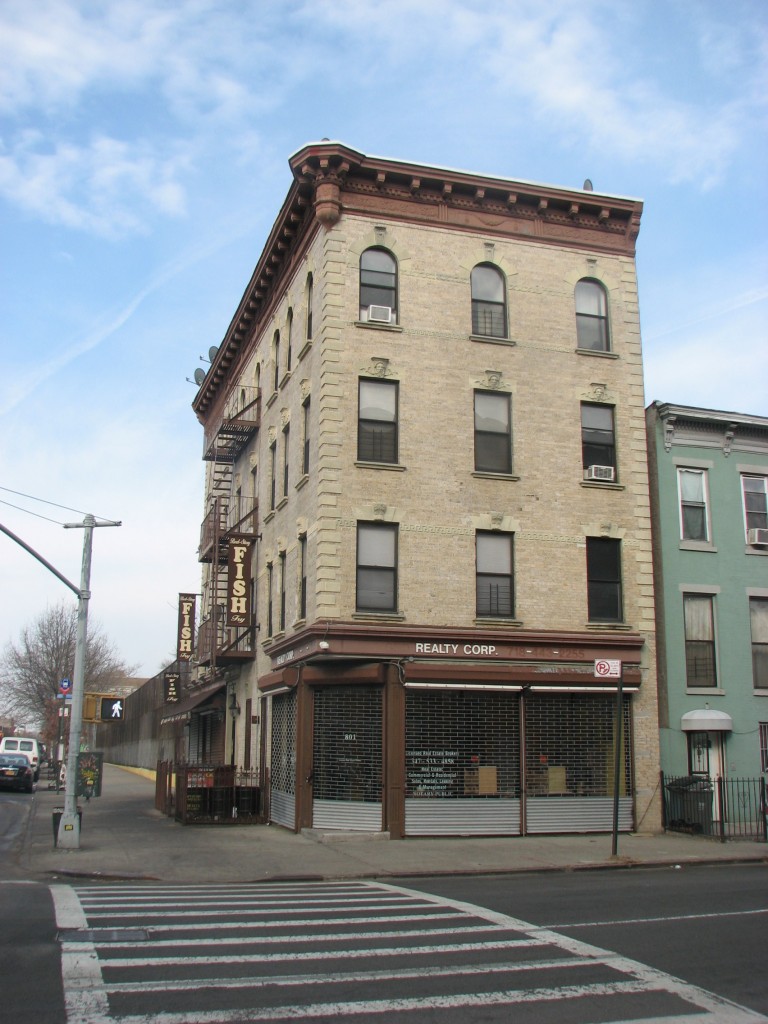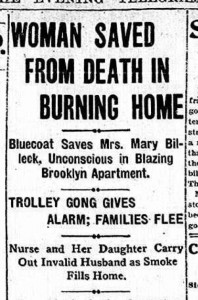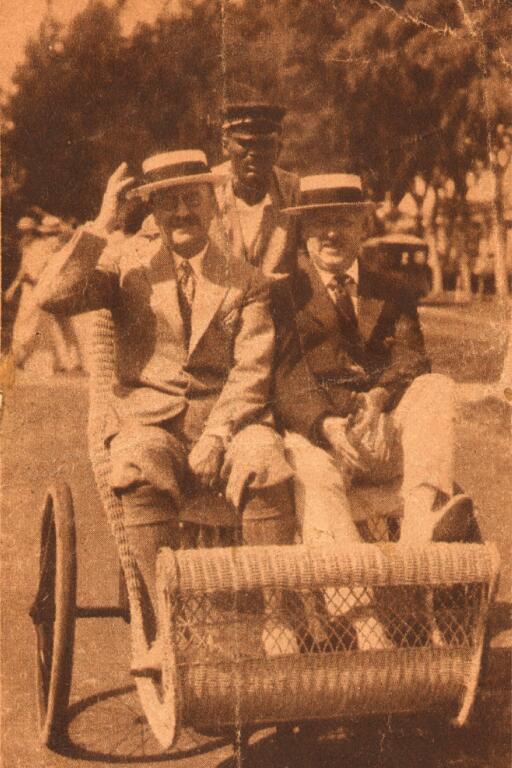THE HERO OF THE HALSEY STREET FIRE (1911)

Brownstone Detectives investigates the history of our clients’ homes.
The story you are about to read was composed from research conducted in the course of one of those investigations.
Do you know the history of YOUR house?
********************************************************************************************************************************

Late in 1911, on a brisk early November morning, a fire broke out in the ground floor store of a 4-story corner apartment building across the street from Saratoga Square Park. It quickly spread, engulfing the entire building.
Smoke pouring out of the store on the ground floor of 801 Halsey Street was first seen by a streetcar motorman, William Coffey, who, thinking quickly, began to clang his streetcar gong to arouse the sleeping inhabitants of the building.
Coffey and his conductor, along with their six passengers, descended from the car and rushed to the building to do what they could do to assist in evacuating the residents.
The fire had apparently started on the ground floor on the Halsey side of the building in a stationery store run by Wolf Bialik. Next door was a grocery store operated by Ernest Seemeyer. The flames then quickly “shot up the dumb waiter shaft to the roof, mushrooming out on each floor.”
DETECTIVE O’HARA TO THE RESCUE
Across the street, at No. 98 Howard Avenue, a 37-year-old police detective, Irving A. O’Hara, upon hearing the street car gong, had begun dressing quickly and rushed across the street to assist.
 By this point, the three families living in the building had made it out of the structure and had gathered across the street in Saratoga Park, staring at the blaze in the gloom of the early morning light. The women “shivered…in Saratoga Park wrapped in the coats of the policemen,” until the families received shelter in the homes of some of their neighbors.
By this point, the three families living in the building had made it out of the structure and had gathered across the street in Saratoga Park, staring at the blaze in the gloom of the early morning light. The women “shivered…in Saratoga Park wrapped in the coats of the policemen,” until the families received shelter in the homes of some of their neighbors.
Eventually, though, someone noticed that Mrs. Bialik, the 41-year-old wife of Wolf Bialik who lived on the fourth floor, was not among the evacuated residents. Det. O’Hara, without a thought for his own safety, darted into the building, climbing through the fire and smoke to her apartment where he found her lying unconscious on the floor.
“Lifting her in his arms he stumbled through the flames down the stairs and into the street.”
Once they were out of the building in the fresh air, Mrs. Bialik recovered, leaving no victims to the fire, save the building.
In the end, the owners of 801 Halsey Street claimed that the entire building was destroyed by the fire to the tune of $10,000. It may have been an overestimation as 801 Halsey Street is still there to this day. Either way, the interior would have had to have been extensively rebuilt and so the building was put out of commission for a period of time.
WHO WAS DET. O’HARA & HOW WAS HE RELATED TO THE MAYOR?

Detective Irving Arthur O’Hara, who’d rushed into the burning building to save Mrs. Bialick, would have a conspicuous career with the Police Department due both to merit and to marriage.
While he would receive commendations for his work as a patrolman, with the department’s bomb squad, and also with its Italian Squad – the NYPD unit that kept a watch on the mob – he was also related to Mayor Hylan (1918-1925) through his sister’s marriage.
Seven years later, in 1918, after Hylan had become mayor, O’Hara was immediately promoted and became the bodyguard of the new boss of the Italian Squad (and later, bodyguard to the Mayor, himself).
Additionally, in 1920, as part of his new high-profile police work with the City, O’Hara sailed with a fellow detective for Italy on police business to take into custody a member of a mob gang that was being extradited to the U.S. for murder. As it turned out, this extradition became the first such request that had ever been honored by the Italian government.
In O’Hara’s possession on the trip was a warrant signed by President Wilson.
In 1925, when Mayor Hylan was voted out of office, O’Hara retired from city service. Before he retired though – just days before, actually – he would be promoted once again, leaving him with a comfortable pension that would support him and his family until his death in 1937.
HOW DID THE FIRE BEGIN?
The Bialiks
The source of the conflagration was never officially determined, although it was decided that the fire began in Bialik’s stationery store. The weather had already turned cold and the fire started in the early morning hours, so the likelihood was that the source had been smoldering coal ashes. These ashes could have been dumped into a pail containing flammable items, or they may have sat in the fireplace grate of the stationery store and, sparking overnight, ignited nearby flammable materials. We’ll never know.
The Bialiks were new to the building, having just moved to 801 Halsey Street within the year. According to the 1910 Federal Census, the “Russian-Yiddish” couple had most recently been renting a 2-story frame house across the street at No. 89 Howard Avenue, where they had lived with their adopted 17-year-old son, Samuel Halpren, and a lodger. The census taker listed Wolf as a tobacconist and Samuel as his clerk.

Could it be that Wolf, who was not mentioned as being present during the fire, had been away visiting family and young Samuel, his adopted son and the store’s clerk, had been allowed to run the store in his absence and closed up the business alone? Had Samuel indiscriminately done something to cause the fire?
Ernest Seemeyer
Ernest E. Seemeyer, who occupied the other business establishment on the ground floor of the building, operated a grocery out of the building. Seemeyer, born in Germany, was 50 years old when the fire struck, and was living at 146 Wyckoff Avenue in Bushwick with his wife, Meta, and their three daughters.

Two years before the fire, in 1908, he had been reported missing by his family. Apparently, according to his wife, he was often disappearing and threatening to commit suicide.
Four years later in 1915, according to the State Census, the family was still living on Wyckoff, and Ernest was running a grocery there. Several months after the census takers had come around (almost exactly four years from the date of the fire), Seemeyer was found dead in a lodging house on Myrtle, the gas “escaping from the jet overhead.” Seemeyer had finally made good on his promises, leaving a suicide note stating that he was tired of his life.
Could the fire have somehow been related to an aborted suicide attempt by Seemeyer? The fire inspector noted that the fire had started in Bialik’s stationery store, but the two stores were side by side, and fire investigations were not exactly a science back in the day.
Seemeyer had attempted suicide several times before the fire and, depending upon when he closed up his store for the night, this may have been yet another failed attempt.

Again, we’ll never know.
POSTSCRIPT
In the April 1925 issue of the New Yorker, a cartoon by Alfred Frueh shows firefighters carrying people from a burning building.
Each person is wearing a placard with notices such as “This lucky lady is being rescued by Mayor Hylan’s firemen.”
Although the cartoon was not meant to be a positive commentary on Mayor Hylan’s policies, it could not have slipped past Detective O’Hara’s notice.
The Hero of the Halsey Street Fire must have been proud.
———————————————————————————————————————–
 Brownstone Detectives is an historic property research agency. Our mission is to document and save the histories of our clients’ homes. From our research, we produce our celebrated House History Books and House History Reports. Contact us today to begin discovering the history of your home.
Brownstone Detectives is an historic property research agency. Our mission is to document and save the histories of our clients’ homes. From our research, we produce our celebrated House History Books and House History Reports. Contact us today to begin discovering the history of your home.